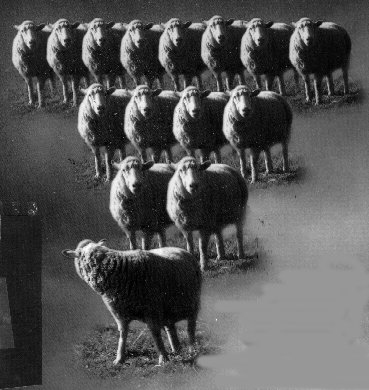Samstag, 5. Juni 2010
Bokanovsky's process
anaconda178, 15:06h
Bokanovsky's Process is a fictional process of human cloning that is a key aspect of the world envisioned in Aldous Huxley's novel Brave New World.
The process is applied to fertilized human eggs in vitro, causing them to split into identical genetic copies of the original. The process can be repeated several times, though the maximum number of viable embryos possible is 96, with 72 being a "good average".
The process is described in detail in the first chapter of the book. The process is not applied to embryos of the Alpha and Beta classes of humans. It is reserved for the Gamma, Delta, and Epsilon classes.
One egg, one embryo, one adult - normality. But a bokanovskified egg will bud, will proliferate, will divide. From eight to ninety-six buds, and every bud will grow into a perfectly formed embryo, and every embryo into a full-sized adult. Making ninety-six human beings grow where only one grew before. Progress.
In the highly-controlled social world, the ability for the government to control the number of humans is important, as is the ability to control the function of those humans.
Bokanovsky's Process, combined with Podsnap's Technique for speeding up the maturation of unfertilized eggs from an ovary, is used to produce massive numbers of a genetic group: "Fertilize and bokanovskify ... and you get an average of nearly eleven thousand brothers and sisters in a hundred and fifty batches of identical twins, all within two years of the same age."
The record number of twins from a single ovary at the London Hatchery is 16,012 in 189 batches. Centers in tropical climates can get better numbers: Singapore created over 16,500, and Mombasa has touched 17,000.
Bokanovsky groups usually work together doing a single task, and by manipulating the in vitro chemicals, various subclasses can be created from a Bokanovsky Group.

The process is applied to fertilized human eggs in vitro, causing them to split into identical genetic copies of the original. The process can be repeated several times, though the maximum number of viable embryos possible is 96, with 72 being a "good average".
The process is described in detail in the first chapter of the book. The process is not applied to embryos of the Alpha and Beta classes of humans. It is reserved for the Gamma, Delta, and Epsilon classes.
One egg, one embryo, one adult - normality. But a bokanovskified egg will bud, will proliferate, will divide. From eight to ninety-six buds, and every bud will grow into a perfectly formed embryo, and every embryo into a full-sized adult. Making ninety-six human beings grow where only one grew before. Progress.
In the highly-controlled social world, the ability for the government to control the number of humans is important, as is the ability to control the function of those humans.
Bokanovsky's Process, combined with Podsnap's Technique for speeding up the maturation of unfertilized eggs from an ovary, is used to produce massive numbers of a genetic group: "Fertilize and bokanovskify ... and you get an average of nearly eleven thousand brothers and sisters in a hundred and fifty batches of identical twins, all within two years of the same age."
The record number of twins from a single ovary at the London Hatchery is 16,012 in 189 batches. Centers in tropical climates can get better numbers: Singapore created over 16,500, and Mombasa has touched 17,000.
Bokanovsky groups usually work together doing a single task, and by manipulating the in vitro chemicals, various subclasses can be created from a Bokanovsky Group.

... comment
pstz,
Montag, 21. Juni 2010, 22:59
Picture and text source
source of text is missing.
Picture well chosen and fitting.
P.S.
Picture well chosen and fitting.
P.S.
... link
... comment